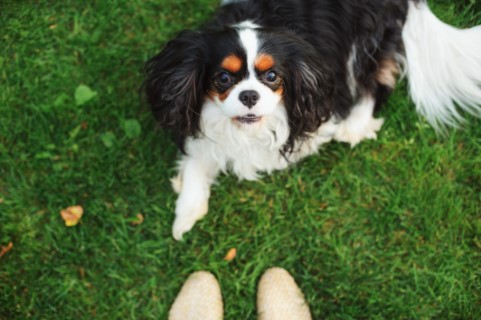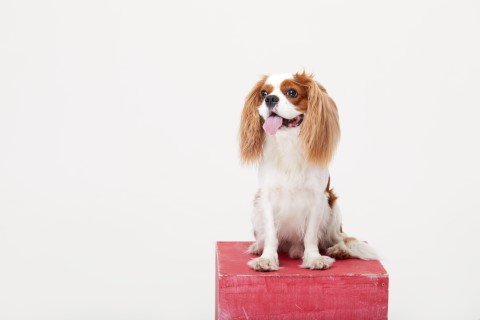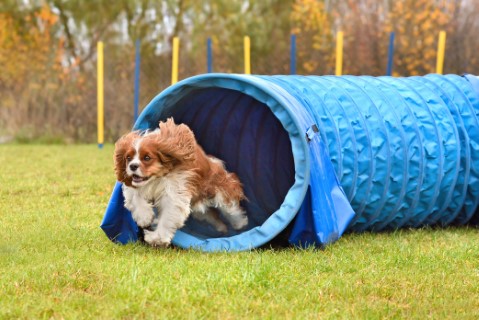The Cavalier King Charles Spaniel is an eager-to-please and highly trainable companion. With the right techniques and plenty of patience, you can mold your Cavalier into a delightful and obedient pet. This comprehensive guide covers the top methods for training your Cavalier King Charles Spaniel.
Start With a Positive Environment
The foundation of effective training is creating an encouraging and rewarding environment for your Cavalier. This builds trust between you and your pup, setting you both up for training success.
Dedicate a consistent training area in your home that is free of distractions. This space should feel safe and comfortable for your dog. Provide plenty of positive reinforcement through small treats, verbal praise (“good dog!”), and belly rubs when your Cavalier performs the desired behavior. This links the behavior with a pleasurable reward in your dog’s mind.
Avoid punishing or scolding your Cavalier for training mistakes. This can cause anxiety and damage your bond. Instead, simply withdraw rewards when undesired behaviors occur. Maintaining a patient, loving attitude makes training enjoyable for you both.
Incorporating playtime into training sessions taps into your Cavalier’s energetic nature. Short 5-10 minute play breaks with toys or fetch keep your pup engaged. Establishing clear verbal and physical cues, like “sit” and a pointed finger, provides consistency and clarity for your dog.
Master the Basics First
Once you’ve set up a positive training area, focus first on basic obedience cues, including:
- Sit – Have treats ready. Hold it above your dog’s nose, then slowly move it above their head. Their nose will follow until they sit. Praise and treat.
- Stay – Tell your sitting dog to “stay.” Take a few steps back, then return and treat. Gradually increase distance.
- Come – Call your puppy’s name excitedly. When they come, give treats and affection. Increase distance over time.
- Down – Show the treat to your standing puppy. Move it down towards floor, causing them to lie down. Reward.
- Heel – With treats, lure your dog into heel position (your side). Praise and treat in position, gradually increasing duration.
Establish a hand signal, like an open palm, for each verbal cue. Be patient and consistent – it takes multiple training sessions for a Cavalier to master commands. Keep sessions brief at first, around 5 minutes. Increase duration gradually as your dog’s focus improves.
Consistently rewarding desired behaviors with treats, toys and praise creates a strong motivation in your Cavalier to repeat them. This positively reinforces the behaviors. phasing out food rewards over time and replacing them with belly rubs and verbal praise.

Socialize Extensively
Cavalier King Charles Spaniels thrive on human interaction. It’s crucial to socialize them early on to a wide variety of people, dogs, sights, sounds and experiences. This prevents shyness and reactivity later in life.
Introduce your Cavalier to new dogs through brief, supervised meetings on leash. Let them sniff each other while you provide praise and treats. Gradually increase interaction time as they become comfortable. Signs of discomfort include raised hackles, growling, or hiding behind you. Immediately end interactions if this occurs.
Visit a wide variety of locations together, like parks, shops and hiking trails. Allow your Cavalier to cautiously explore while remaining calm and providing encouragement. Carry treats to create positive associations. Expose your dog to sounds like vacuum cleaners, cars and crowds from a distance at first.
Invite friends and neighbors to your home to meet your puppy. Include people of diverse ages, appearances and abilities. With time, your socialized Cavalier will be comfortable interacting with anyone in any environment.
Employ Positive Reinforcement
Positive reinforcement should be your main training method with Cavalier King Charles Spaniels. This means rewarding desired behaviors and ignoring unwanted ones. Positive reinforcement tapping into your dog’s desire to please you.
Food rewards are highly effective for most dogs. Tiny pea-sized treats work well. Meat, cheese or veggie varieties provide variety. Gradually phase out food rewards as your Cavalier becomes reliably trained.
Verbal praise is another key reward. Express excitement using an enthusiastic tone when your dog correctly performs a cue. Petting, belly rubs and games are other options.
To use positive reinforcement:
- Give a clear verbal or physical cue, like “sit.”
- As soon as your dog performs it, provide the reward. This links the reward to the behavior.
- Gradually increase the duration between cue and reward as your dog masters the skill.
Rewards should be given every time during initial training. This consistently reinforces the association between command and reward. As your Cavalier becomes proficient, provide rewards intermittently.
Schedule Regular Training Sessions
Consistent, brief daily training sessions are vital for effectively training your Cavalier King Charles Spaniel. Training for just 5-10 minutes at a time prevents your pup from becoming bored or distracted. Try to train at the same time each day – for instance, right before their morning walk.
Keep a written training log to track your Cavalier’s progress. Note which cues they excel at, which need more work, and any questions or issues. Review it weekly to ensure you’re advancing properly on key skills. This also helps identify plateauing behaviors that need a modified approach.
Incorporate play breaks between training segments to reboot your Cavalier’s energy and motivation. A few minutes of fetch or tug-of-war rejuvenates your pup’s focus for the next round of training.
End each session on a positive note by finishing with a cue your dog reliably performs well. Provide ample praise and reward. This sends your Cavalier off with a sense of accomplishment!
Adapt Sessions to Your Cavalier’s Personality
Cavalier King Charles Spaniels are typically highly motivated to work for praise and food rewards. However, each dog is unique. Tailoring training to your Cavalier’s personality enhances engagement and success.
Shy dogs require extra-gentle handling and encouragement. Introduce new skills gradually in short sessions. Provide high-value food rewards for progress.
Easily excitable Cavaliers benefit from a calm, patient approach. Keep introductory sessions low-key to avoid overwhelming them.
Independent pups may need more real-life rewards like games or walks, rather than treats alone. Determine what interests your unique Cavalier most.
Pay close attention to your dog’s stress signals like yawning, lip licking or averting their gaze. This indicates discomfort. End sessions immediately on a positive note if stress arises.
With time and observation, you’ll discover the ideal training techniques to motivate your Cavalier and keep them engaged.

Introduce New Skills Patiently
When introducing new behaviors beyond basic commands, be sure to progress gradually so your Cavalier can master foundational skills first. Rushing ahead too quickly will only confuse your dog.
Break down complex tasks like fetching a ball into small steps. For instance:
- First, teach your dog to pick up a ball on cue.
- Then reward carrying the ball briefly before dropping it.
- Next, toss the ball a very short distance and reward retrieval.
- Finally, increase distance and encourage your dog to bring the ball all the way to your hand.
Advancing incrementally allows your Cavalier to polish each component of the skill before moving to the next. Always end a session on a positive note with a command your dog can perform well. This avoids frustration for you both.
Introducing new environments, people and dogs should also be gradual. Move closer in small increments as your Cavalier becomes desensitized and shows comfortable body language. Providing high-value treats helps create positive associations.
Patience and increments are vital in introducing new skills to eager Cavalier King Charles Spaniels. Allow your intelligent pup to absorb lessons at their own pace.
Address Problem Behaviors Positively
Despite your best efforts, your Cavalier may occasionally display undesirable behaviors like barking, nipping or separation anxiety. Patience and positive methods are essential to correcting these issues.
First, identify what’s triggering the behavior by keeping a journal of occurrences. Your Cavalier may bark due to fear, excitement, or wanting attention. Appropriate solutions can then be implemented.
Redirect your dog’s focus to a positive alternative behavior when issues arise. For example, interrupt barking by asking for a “sit” or “down” using a treat lure. Reward your Cavalier once they comply to reinforce the desired calm behavior.
Separation anxiety can be improved through gradual alone training. Begin with very short departures while providing food puzzles or chews. Slowly increase your absence duration over weeks.
Remember, scolding or punishing will only increase your Cavalier’s stress. Consistently reward good conduct and ignore unwanted behaviors. Professional training can provide guidance on resolving issues. With time and positive methods, your dog’s good nature will prevail.
Troubleshoot Training Challenges
Despite your best efforts, training challenges inevitably crop up. Troubleshooting common issues requires patience, creativity and detective work.
If your Cavalier struggles to master a skill, consider simplifying the cues. For a “down” command, try guiding them gently into position, praising, then adding the verbal cue. Shape the desired response in small steps.
For dogs that are easily distracted, conduct training sessions in a low-stimulation room. Minimize sights and sounds that compete for your pup’s focus. Gradually add distractions as their focus improves.
If your Cavalier loses motivation for rewards, try introducing new high-value treat varieties or incorporating fun rewards like playtime. Keeping sessions upbeat and short prevents boredom.
Identifying the triggers for unwanted behaviors can reveal solutions. If your dog jumps on guests, have them turn away and only give attention when all paws are on the floor. Consistency modifies the behavior.
Seeking input from professional trainers can provide fresh troubleshooting insights. Customized guidance gets training back on track when you feel stuck. Remember, slow and steady wins the race. Stay positive!
Maintain Consistency
To fully cement skills, Cavalier King Charles Spaniels require consistency across their daily lifestyle and all family members involved in training.
Use the same cue words like “sit” and “stay” to avoid confusion. Make sure everyone uses identical hand signal cues as well. Consistent verbal praise like “Good dog!” also prevents mixed messages.
Set clear household rules and stick to them, such as no begging at the table or jumping on guests. Gently reinforce the rules with every family member. Dogs thrive on structure and predictable routines.
Maintain training even during hectic times. Prioritize 5-minute mini training and play sessions daily to keep your Cavalier’s skills sharp. Consistency is key, even when life gets chaotic.
Training a Cavalier King Charles Spaniel takes plenty of consistency, positive reinforcement and patience. By tapping into your dog’s loving nature and establishing robust training foundations, you’ll develop a lifelong canine companion. Bring out the best in your Cavalier with these proven techniques!

Leave a Reply